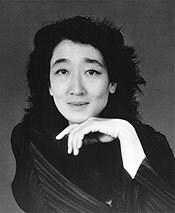S & H Concert Review
Kurt Sanderling 90th Birthday Concert: Mitsuoko Uchida (pf), Philharmonia Orchestra, Christoph von Dohnanyi, RFH, 28th September 2002 (AR)
HAYDN: Symphony No. 64 Tempora mutantur
MOZART: Piano Concerto No. 27, K595
BRAHMS: Symphony No. 2
Kurt Sanderling’s 90th Birthday Concert consisted of three essentially dark and dramatic works. Christoph Von Dohnanyi opened his programme with Haydn’s Symphony No. 64 Tempora mutantur .- Times change. Some scholars have suggested that this nickname is associated with the principle theme of the Finale but listening to Dohnanyi’s penetrating performance it seems more appropriate to the experience and elements of fragmented time in the Largo. It was in the Largo that the composer’s hybrid and inventive writing anticipates Bruckner’s dynamics with their infamous gaps - eternal blank spaces - between the notes.
Dohnanyi conducted this fascinating score without a baton, achieving intimacy with his players and getting textures of great clarity and transparency. The Philharmonia Orchestra was rightly reduced to a size similar to the ensemble available at Ezsterháza. While this work was only around twenty minutes long in ‘real time’, Haydn’s radical playing around with dynamics and spaces made the work seem a great deal longer.
Unfortunately many concertgoers missed this rarely performed symphony, arriving late after a bomb scare at Waterloo. It would also be refreshing if Dohnanyi could conduct a series of Haydn’s less well known symphonies with the Philharmonia rather than the customary Beethoven Symphony cycles.
The celebrated and charismatic pianist Mitsuko Uchida played the Mozart 27th Piano Concerto with vitality and wit, imbued with a moving passion. Her performance was, in a word, exquisite. She is one of that rare group of pianists who seem to be able to combine a rigorous intellect with an ability to convey a wide variety of emotions, equally at ease with Schoenberg or Mozart. She plays with a broad range of sound sensations which defy description. Her playing had an extraordinarily hypnotic effect, making it difficult to pin down and analyse her playing as she seamlessly floated her phrases which melted on impact.
In front of me was what I took to be a critic vigorously writing a myriad of notes and missing her actual playing. I do not believe one can take in such subtle playing while jotting down notes. I could not imagine this concerto having a finer and more insightful player than Ms. Uchida, an artist who perfectly embodies the art which conceals art.
Ushida is embarking of a project to record all of Mozart's Piano Concerti with the Cleveland Orchestra between the autumn of 2002 and 2007. She said: "It was a dream of mine to do this specific project with this orchestra, because I know the Mozart recordings of George Szell and I thought his accompaniments were unbelievable." On the strength of this evening’s performance, this set of recordings should be a must-have for Mozart lovers and anyone who appreciates truly great piano playing.
Brahms’ 2nd Symphony is often ludicrously referred to as his ‘sunny’ or ‘Pastoral’ Symphony. In my view, this cliché view is absurd: it is in fact tragic, nostalgic and brooding. Dohnanyi treated the first movement - Allegro non troppo - in this melancholic vein. He conducted with a broad brush and dark-hued palate, bringing out the sense of lowering tragedy in the work. The trombones in particular produced a rich, deep, sombre sound, whilst he coaxed the strings to play with urgency and agitated aggression.
The slow movement - Adagio non troppo - suffered from a sour horn sound and the conductor did not dig deep enough. This was mediocre music making, but the Allegretto grazioso quasi Andantino had bite, bounce and attack, and seemed the most successfully realised movement, without mannerisms. The last movement - Allegro con spirito - was played with great gusto, with the strings and trombones adding extra intensity, and again it was the horns who seemed out of sync. While the conductor gave off a white-hot energy and drive, the closing brass passages didn’t quite have the necessary visceral lift.
Alex Russell

 Return to:
Return to: